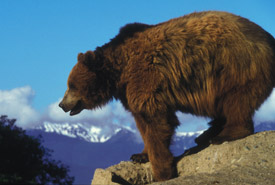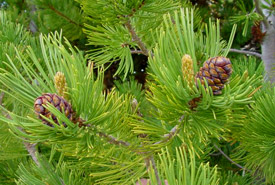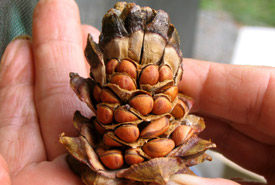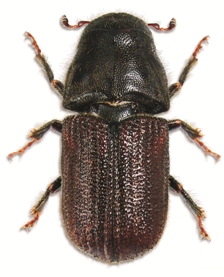Pines, beetles and bears, oh my! The relationship of bugs, bears and trees in western Canada and the U.S.

Grizzly bear (Photo by Erwin and Peggy Bauer/USFWS)
A Huffington Post article titled “In The American West, A Battle Unfolds Over Bugs, Climate Change And The Fate Of An Iconic Species” recently caught the eye of staff at the Nature Conservancy of Canada (NCC). In it, writer Kate Sheppard describes how the increasing mortality in whitebark pines due to mountain pine beetle infestations is impacting the food supply for grizzly bears.

Whitebark pine needles and cones (Photo by Richard Sniezko)
Whitebark pine infestations have been on the radar for about a decade now. Scientists in both Canada and the U.S. have been tracking the die-off annually. Indeed, in places like Yellowstone it is a big deal. That’s because grizzly bears in that part of the world rely on whitebark pine seeds a major food source in the fall.
The further north you go, the less this food source becomes a factor, to the point where in Banff it is a rare occurrence to find whitebark pine seeds in a bear’s diet. North of the 49th parallel, whitebark pine is found in isolated stands a high elevation, which is mostly on public lands. The Waterton Park Front area has a few stands at lower elevations but there are few stands on NCC lands in Alberta.

Whitebark pine seeds in cones (Photo by Don Pigott)
For the grizzly bears of Yellowstone, their options become quite limited in late fall. Whitebark pine seeds are not like berries, in the sense that they are available for a longer time period. The berry season comes and goes but pine seeds are useable when most other foods have long since desiccated. So in the late season the only fallback becomes roots, which are not very nutritious. This does not make for fat bears going into the den.

Mountain pine beetle (Photo by Wikimedia Commons, Steve Clarkson)
This diversity in food sources explains why there is so much consternation over the loss of whitebark pine, as it has the potential to turn a fat, happy and very productive grizzly bear population into a skinny, food stressed and poor production population (like the one in Banff National Park).
In southwest Alberta, NCC is part of a multi-year grizzly bear population monitoring project. Researcher Andrea Morehouse’s study, which includes some NCC properties, is helping conservationists on both sides of the Canada-U.S. border gain a better understanding of grizzly bears’ habitat requirements and ranges.


